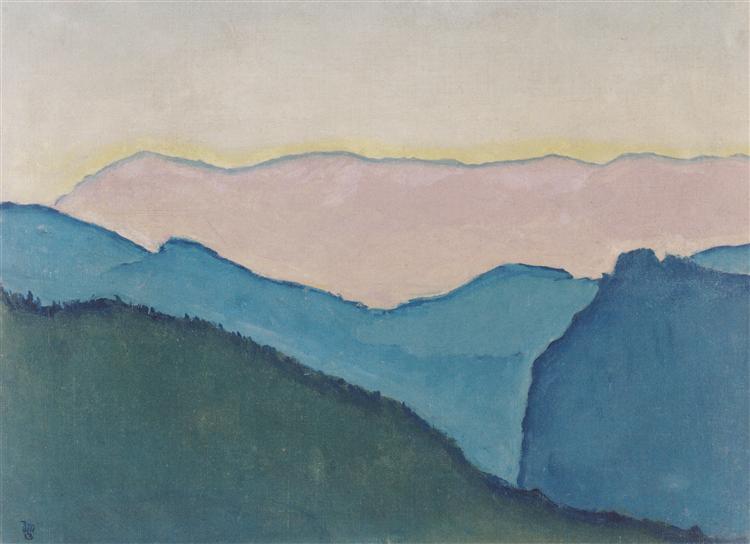Description
Koloman Moser, austrian artist of renowned and a central figure of the Vienna Secession Movement, presents in his work "Cordilleras" (Mountain Ranges - 1913) A fascinating exploration of the natural landscape through its characteristic decorative and ornamental approach. The painting, of a rich complexity, invites the spectator to immerse himself in a world where nature is dyed of intense emotionality and a sophisticated formal simplification.
In this work, Moser moves away from the realistic representation of the landscape to adopt a more stylized and symbolic vision. The composition stands out for the use of wavy lines that delineate the mountains, creating a visual rhythm that can remind the traditions of Japanese art, with which Moser was particularly fascinated. This approach not only beautifies the form, but also suggests a deep connection between the human being and nature, a recurring theme in his work and in the modernism of the time.
Color use is a fundamental element in "mountain ranges." Moser uses a palette that combines vibrant and subtle tones, where blue, green and ocher predominate, evoking both the serenity and majesty of the mountain landscape. These colors not only create an atmosphere of calm, but also invite the viewer to a contemplative reflection on the greatness of nature. The way in which the colors are combined and overlap allows depth that is often achieved by using layers, something that reinforces the dimensionality of the work.
It is interesting to note that Moser does not include human figures in this painting. By dispensing with characters, it focuses exclusively on the landscape, which suggests a desire to highlight the intrinsic relationship between the natural environment and the internal experience of the individual. This decision resonates with the spirit of modernism, where a particular emphasis on introspection and subjectivity is placed.
In terms of style, Koloman Moser was a pioneer in the search for new visual languages in art. His work "Cordilleras" embodies the characteristics of Art Nouveau, with his love for fluid lines and natural forms, but also offers a look at the future path of modern art. His ability to merge the ornamental with the abstract places him in a prominent place not only among the Viennese, but in the broadest context of the history of European art.
Comparing "mountain ranges" with other contemporary works, it is possible parallel traces with the productions of artists such as Gustav Klimt, who also experimented with ornamentation, although Moser is distinguished by his approach more focused on landscape representation. Thus, "Cordilleras" can be interpreted as a sublime example of the potential of the landscape in modern painting, a vehicle for emotional exploration and spiritual connection.
In short, "Cordilleras - 1913" It is not only a masterpiece of Koloman Moser, but it is also a visual proposal that invites reflection on the relationship between the human being and the natural world. Its composition, colorful and the absence of human figures form a coherent set that resonates with the search for new forms of artistic expression in the context of the beginning of the twentieth century. Moser, with his unique gaze, offers us a visual and emotional respite, a true gift in the canon of modernist art.
KUADROS ©, a famous paint on your wall.
Hand-made oil painting reproductions, with the quality of professional artists and the distinctive seal of KUADROS ©.
Art reproduction service with satisfaction guarantee. If you are not completely satisfied with the replica of your painting, we refund your money 100%.

